Dear Reader, in this age of AI created content, please support with your goodwill someone who works harder to provide the human-made. Sign up at the top of the lefthand column or bottom of this page. You will receive my hand illustrated monthly newsletter RESTORE NATURE and access to the biodiversity garden design course as I write...and nothing else, I respect your time. I am also removing the advertizing as best I can as its become intrusive inappropriate and pays me nothing.
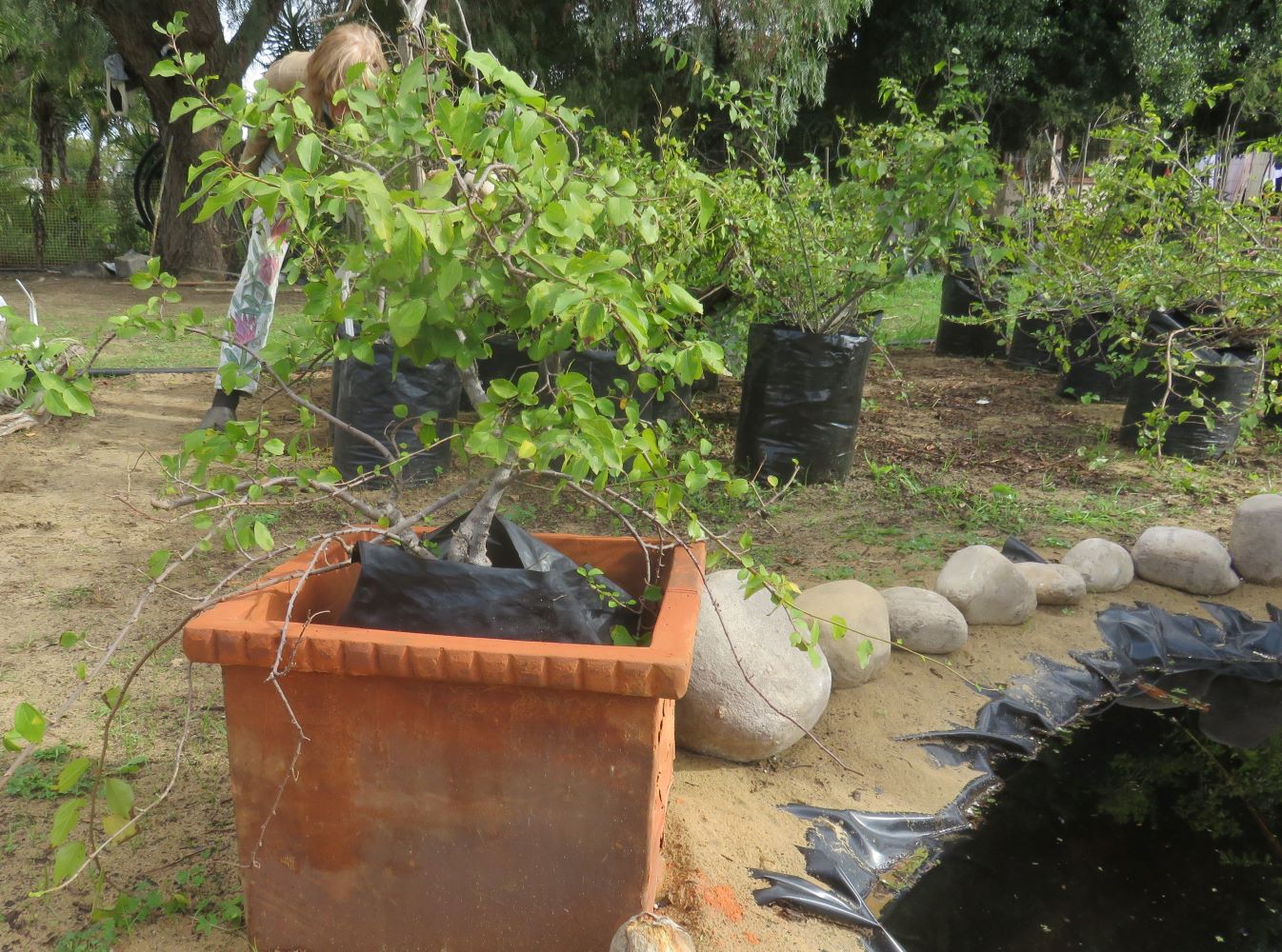 Grewia occidentalis plants in the Toos van den Berg nursery, Lucullus road Kraaifontein.
Grewia occidentalis plants in the Toos van den Berg nursery, Lucullus road Kraaifontein.18 reasons why
Grewia occidentalis is
the perfect hedge plant !
Grewia occidentalis or “kruisbessie' (its beautiful range of indigenous names will be discussed at length below) has to be one of the best hedge plants globally, let alone in the areas where it is native. I've listed eighteen reasons why this is so. You will see why this plant is so exciting and ideal for hedging as you read on.
Why the native hedge is so important in wildlife gardening
Many local gardeners turn to the limited commercial range of exotics when it comes to hedging and miss the chance of preserving botanical diversity and creating excellent habitat for wildlife that comes when planting natives.
The perimeter of your garden actually constitutes a huge area. Take the ubiquitous suburban 450 square meter plot with a 100 square meter cottage on it. If the perimeter has a hedge 1 meter wide all round, minus a gate and driveway, this is about 70 square meters or 20% of the garden area ! The hedge can make a major contribution to the indigenous content in your garden without getting in the way of food growing and other uses of the garden space. Preferably make a mixed hedge, using a number of species. You can find a diversity of native hedge plants covered on this website, and for sale at a nursery like Toos van den Berg. Look at Euclea, Carissa, Gymnosporia and Dovyalis too. They are, like Grewia, all fruiting hedges. I am writing about them because they are so important to the indigenous ecology of your garden and this is often not leveraged, though hedging makes up a major portion of the sales in a nursery business. Start demanding natives and the nurseries will follow.
Why is it one of the best hedge plants ?
Grewia occidentalis in the garden
The cross-berry, as it is known locally in English, is a naturally small tree or shrub. This means that when used as a hedge it will not outgrow its space constantly which requires a lot of pruning work. This is the second reason, beyond being native, that makes it ideal for hedging. It is usually 2-4 meters high as a tree, with a spread of 2-3 meters. The maximum height under favourable conditions is about 7m.
(references 1, 2, 3, 5, 8).
Grewia occidentalis is such a flexible, unfussy plant ! It can be fast growing initially, up to 1.5 meters a year, and then slow down when it reaches full height. It rapidly forms a screen if you require this. European authors describe its growing speed as average, or average rapid growth, perhaps due to lower temperatures there. It is tolerant of pruning and shaping. All these characteristics are ideal for hedging plants and the third and fourth reasons why it gets my best hedge plant crown.
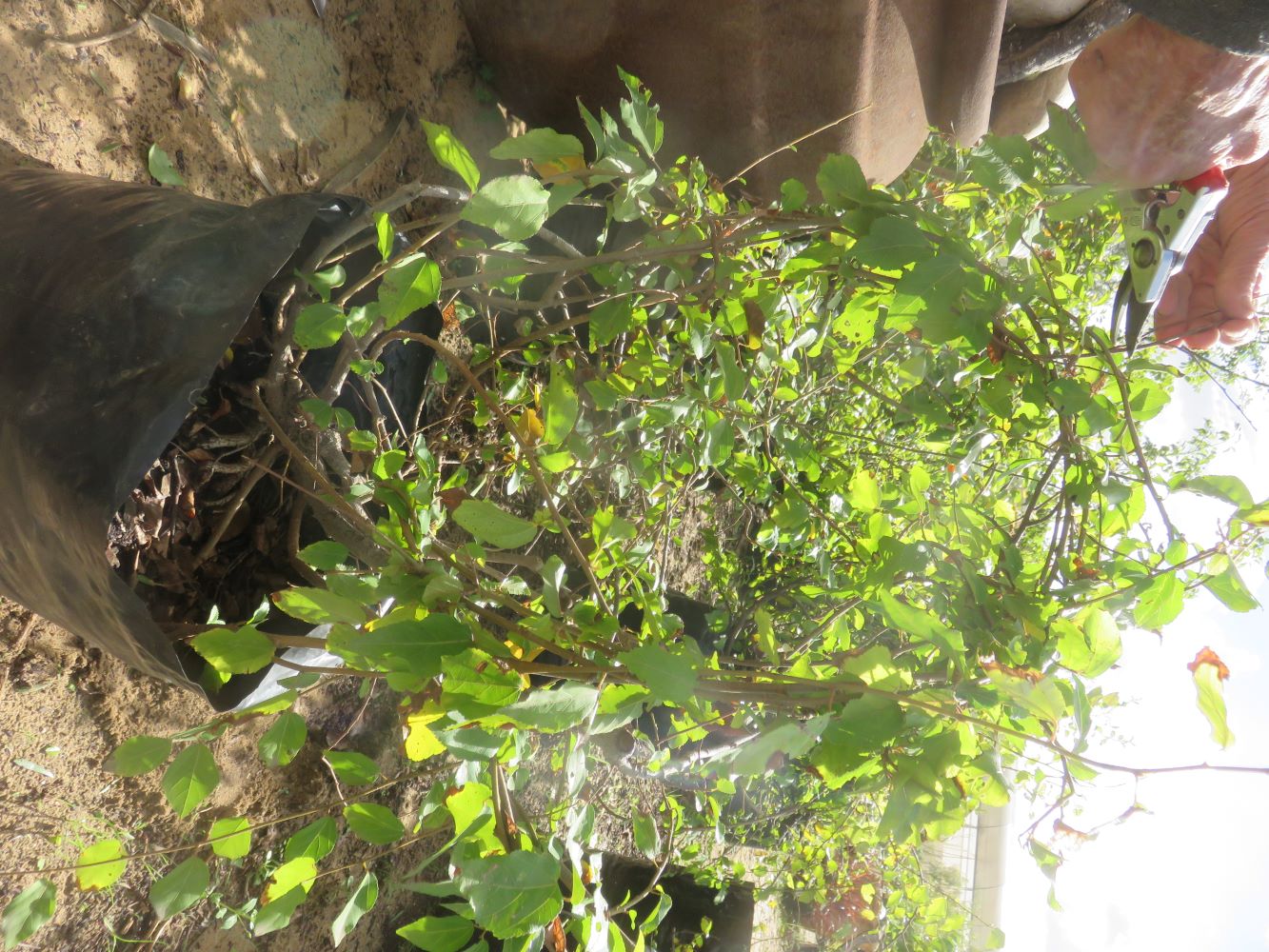 The branches of the kruisbessie are so flexible, they can form a living wreath.
The branches of the kruisbessie are so flexible, they can form a living wreath.Experience the beauty of nature,
and spare your back
Grewia occidentalis is not only suitable for hedging. It also makes a beautiful small ornamental tree with a lovely shape and beautiful grey bark to stand alone as a focal point in small gardens (Glenice Ebedes on the website 'Plantbook') or can be used as part of a mixed flower border, and it is even described as 'showy' when its purple blooms appear in summer. It naturally works beautifully in a bushveld, forest or woodland themed garden (Glenice Ebedes).
Its flexibility doesn't end there. It can be grown in pots, even making a good bonsai subject, and should be potted up in fertile loam with coarse sand or agri-perlite for good drainage, but as long as the soil drains well it will adapt to any soil (reason number five !). Thus it tolerates clay, and some compost will allow it to really thrive. Otherwise it is a low maintenance plant generally.
The growth is described as either upright or scrambling with lax prostrate branches (Pietro Puccio). It tends to be multi-stemmed (reason number six), but you can prune and train it when young to suit your requirements. Its branches are flexible and it takes drastic pruning (reason number seven), and can be trained into topiary, or on an espalier, even as a ground cover (Pietro Puccio) !
Some authors claim it grows in both sun and shade, while others are more specific, stating that it grows best in sun and can tolerate semi shade, or that it needs at least 3 hours of sunshine (Glenice Ebedes). Its flexibility with regard to light is reason number eight.
All authors agree that the roots are non aggressive which is such a boon in urban areas, especially on one's boundaries, another plus for a hedge plant and reason number nine ! It can be planted close to buildings and paving.
Grewia occidentalis will grow in tropical, subtropical and warm temperate regions of the world, coping with temperatures down to -5 degrees C for very short spells, because the leaves begin to suffer at -2 degrees C. The adult trees can take this level of frost, but you'll need to protect young plants from the cold. If planted in pots in zones with harsh sub zero winters they must be taken indoors where there is bright light and the temperature remains above 10 degrees C (Pietro Puccio). This tolerance of diverse climates has to be reason number ten.
It withstands coastal conditions and wind, other reasons for it making an excellent protective hedge plant and reasons number eleven and twelve.
It is water wise, very drought hardy, requiring very moderate watering (reason number thirteen), but is extremely grateful for regular watering in summer. For the lushest results it should be irrigated regularly and abundantly during the summer growing season and more sparsely in winter, allowing surface soil to dry out between watering. It can be fertilized monthly with a balanced liquid fertilizer.
(Pietro Puccio and references 1, 2, 3, 4, 7, 8).
But I've left the best for last ! This is not only an extremely flexible ornamental tree, it is very useful if you want to attract wild life to your garden, and you want to grow native food and medicinal plants. I will delve deeper into these topics below !
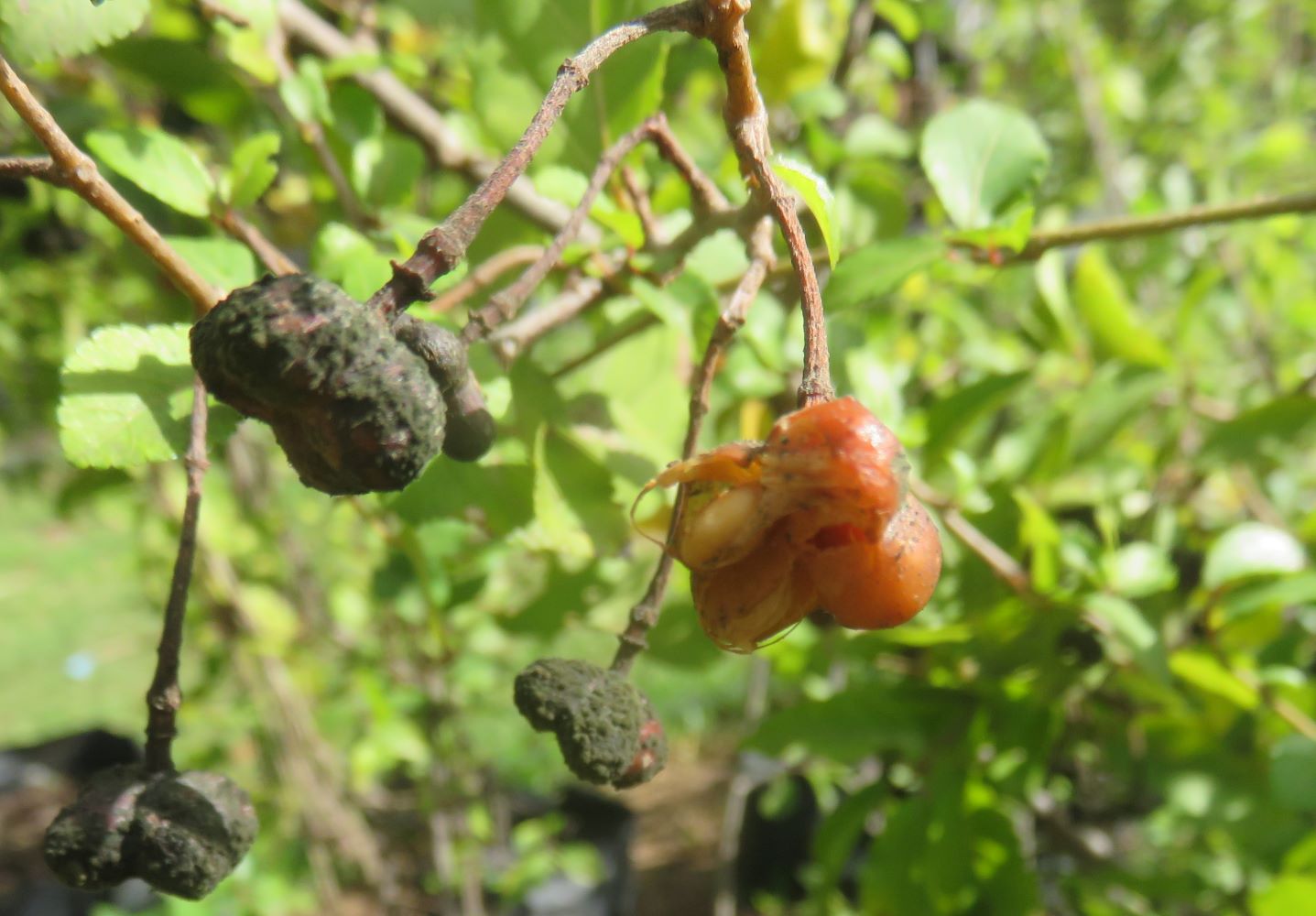 The four lobed fruit have often been pecked by birds.
The four lobed fruit have often been pecked by birds.Grewia occidentalis is a medicinal plant
with edible berries and many other uses
The fruit is edible (reason number fourteen). I've actually tasted it, introduced to it by a Zimbabwean colleague in a nursery I worked at. It is sweet, so it makes sense that its used to brew beer traditionally. The sweetest berries are dried to preserve them. They can be boiled in milk to make a drink, or added to goat's milk yoghurt.
Shampoo can be made from the crushed bark to prevent greying hair. The bruised bark steeped in hot water is also used as a wound dressing. The roots can be used to treat bladder problems and aid childbirth, and parts of the plant have been used to treat impotence and sterility. Its useful medicinal properties make reason number fifteen to plant this as a hedge.
The wood has been used to make bows, spear shafts, and walking sticks, and used for making small craft items, because it is so resistant and flexible and easy to work at the lathe (Pietro Puccio).
(references 1, 2, 3, 6, 8, 9).
Grewia occidentalis gives you
nature in the garden
Grewia occidentalis is an essential plant for the African wildlife garden. Its excellence as a host plant and food for wildlife make reason number sixteen for using it as a hedge plant. In addition to game animals like black rhino, giraffe, nyala and grey duiker and livestock which browse on its leaves, the caterpillars of the Rufous-winged Elfin (Eagris nottoana) and buff-tipped skipper (Netrobalane canopus) butterflies, and 19 species of moth feed on its leaves ! Unfortunately there are no free images of the butterflies but you can google them easily. The Buff tipped skipper is a rich creamy white with pale grey blotches, and the tips of the wings and margins along the body are decorated by baroque swirls of copper brown with chocolate brown accents. The Rufous-winged Elfin is rust coloured with irregular paler patches circled with darker brown. Both are exquisite small butterflies. The moths are also gorgeous. For example Lophostethus dumolinii, which is a rich khaki colour with white feelers, and dark brown triangles on the wings decorated with a white arrow pointing at a full stop. The head and thorax are adorned with a blackish anchor shape
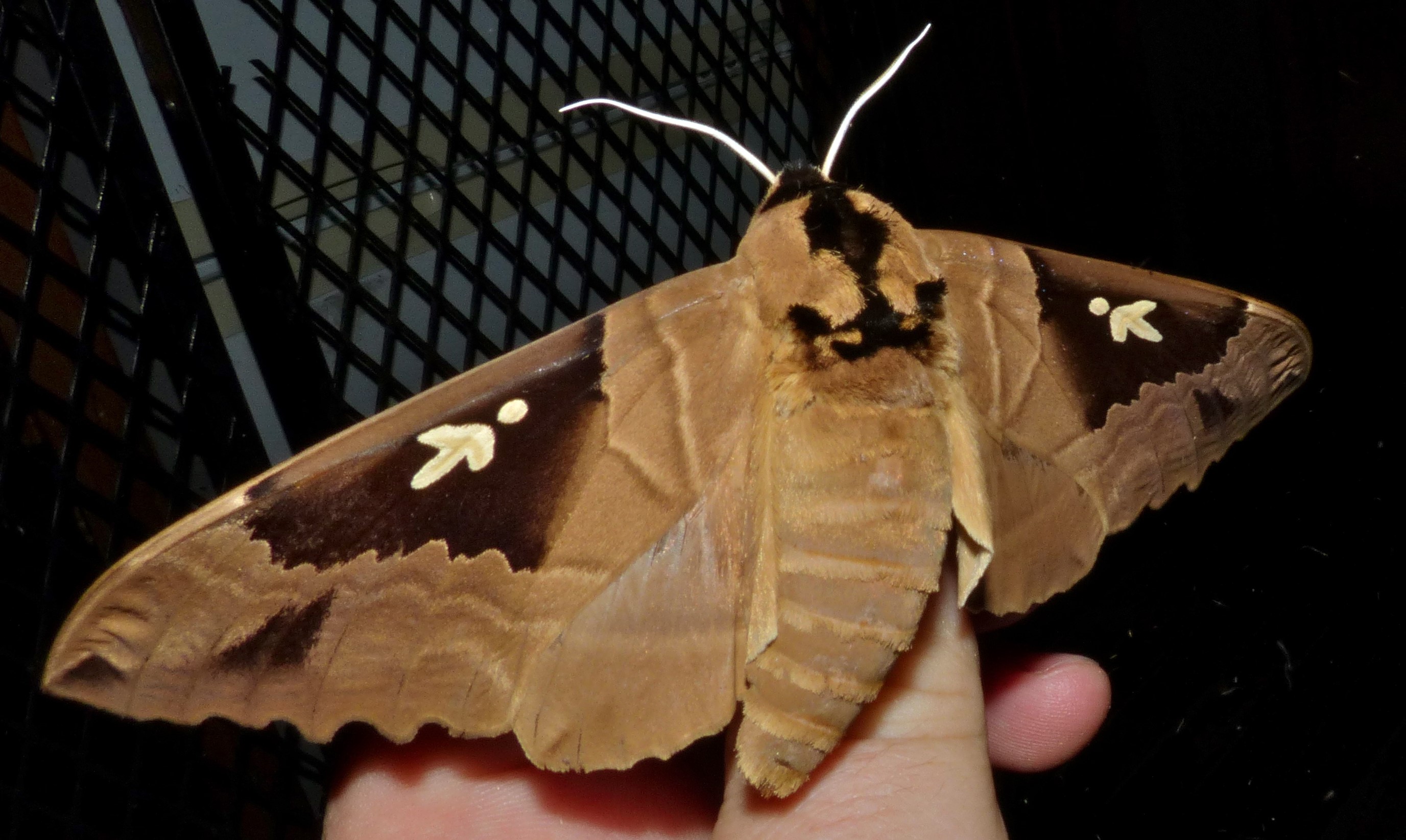 Lophostethus dumolinii is one of the 20 moths and butterflies whose larvae eat Grewia occidentalis leaves. Wikipedia photo by Bernard Dupont at the Lower Sabie camp, Kruger Park.
Lophostethus dumolinii is one of the 20 moths and butterflies whose larvae eat Grewia occidentalis leaves. Wikipedia photo by Bernard Dupont at the Lower Sabie camp, Kruger Park.The sweet fruit which appear in summer and autumn are eaten by birds such as louries, mousebirds, bulbuls and barbets and fruit eating mammals such as monkeys and humans. These animals aid in seed dispersal as digestion readies the seeds for germination. Bees, wasps, butterflies and other insects are attracted to its flowers. Insect eating birds such as nesting birds, will follow these nectivorous insects and the caterpillars. The tree provides shelter and nesting sites for birds.
If the Grewia occidentalis tree doesn't fruit, you can attract more insects to the garden by planting Aptemia cordifolia, Bulbine frutescens and Anisodontea (mallows) says Glenice Ebedes. So there is a tip for attracting bees and other insects to your garden. Another reason for the lack of fruit may be that the gardener has only a one specimen. See the section on the flowers below.
(references 1, 2, 3, 4, 6, 7, 8, 9)
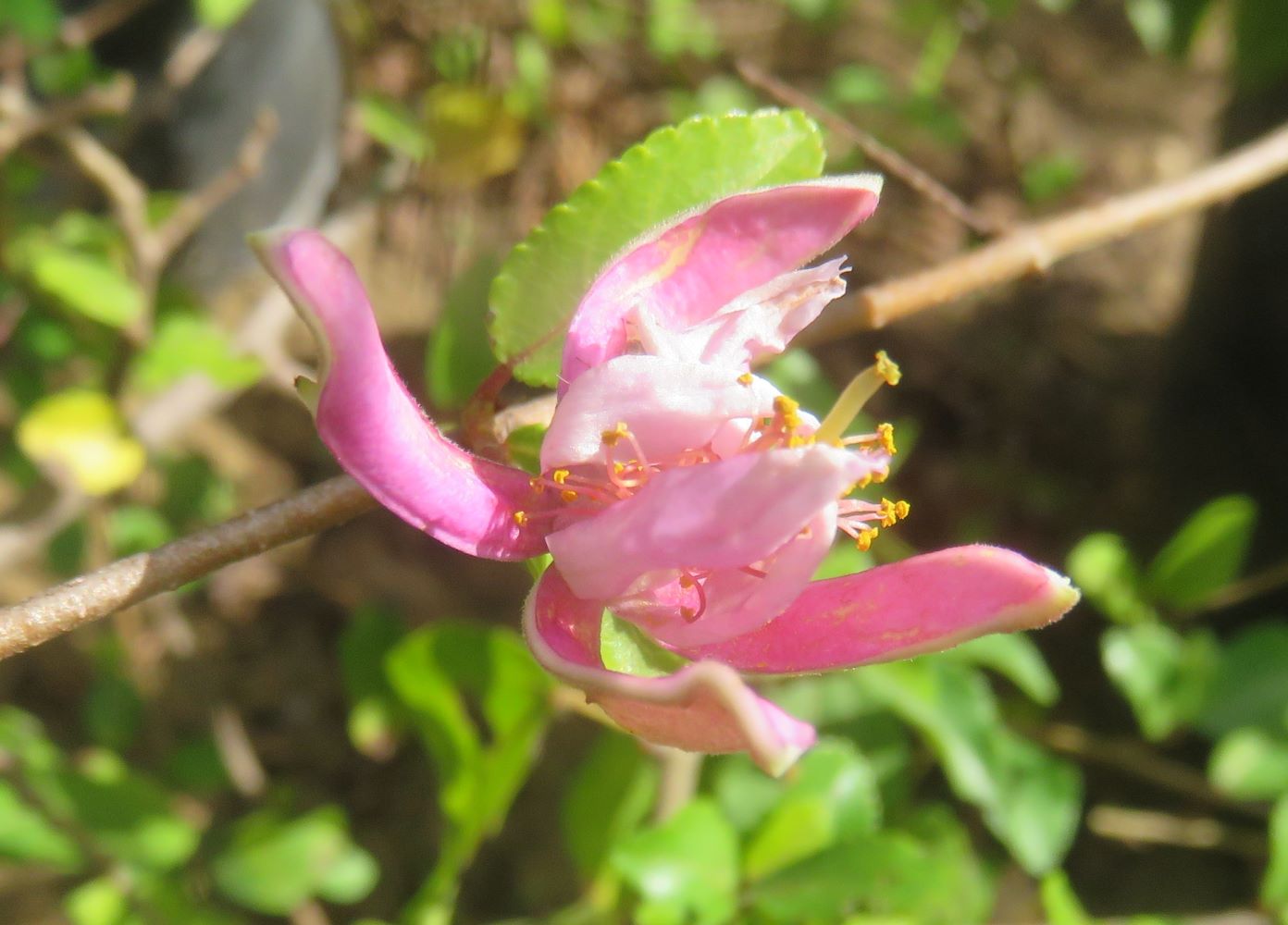 Grewia occidentalis flowers can have pink sepals and petals with bright yellow anthers.
Grewia occidentalis flowers can have pink sepals and petals with bright yellow anthers.Mauve star shaped wild flowers
and delicious fruit
The pretty star shaped flowers of Grewia occidentalis appear in spring to summer (August to January in South Africa) and can put on quite a show, reason number seventeen, and attract pollen and nectar loving insects. They can be mauve, sometimes pink and more seldom white, and up to 3 cm across. They have 5 sepals and 5 petals, and a prominent central mass of bright yellow anthers. One to three flowers are borne opposite the leaves on an axillary, cymose flower peduncle 1 to 1.4 cm long. The pedicel is pubescent and up to 1 cm long. The calyx has 5 linear lanceolate sepals with acute apices, They are about 1.5 cm long and coloured the same as the flower on the inside, and greenish-white on the outside. There are 5 oblong-linear petals, about 1.3 cm long, ranging from mauve to pink and rarely white. The flower bears numerous stamens of the same colour as the flower, with yellow anthers, and a four lobed ovary with a style about 1cm long and a four lobed stigma. As you can tell, the flowers are hermaphrodite, but they are protandrous, which means the pollen ripens earlier to prevent self pollination (Pietro Puccio). Therefore cross pollination with another plant is a necessity, by definition. Having no other Grewia occidentalis in the vicinity in addition to lacking insects in the garden may be why trees bear flowers but no fruit.
(references 1, 2, 3, 4, 5, 7, 9, 10).
Grewia occidentalis' unusual looking and tasty fruit are four lobed drupes forming a cross shape. They ripen from green to shiny orange or reddish brown, are about 25mm across, and can remain on the tree for quite a while, look decorative and attract fruit eating animals.
(references 1, 2, 3, 4, 5, 7, 8, 9).
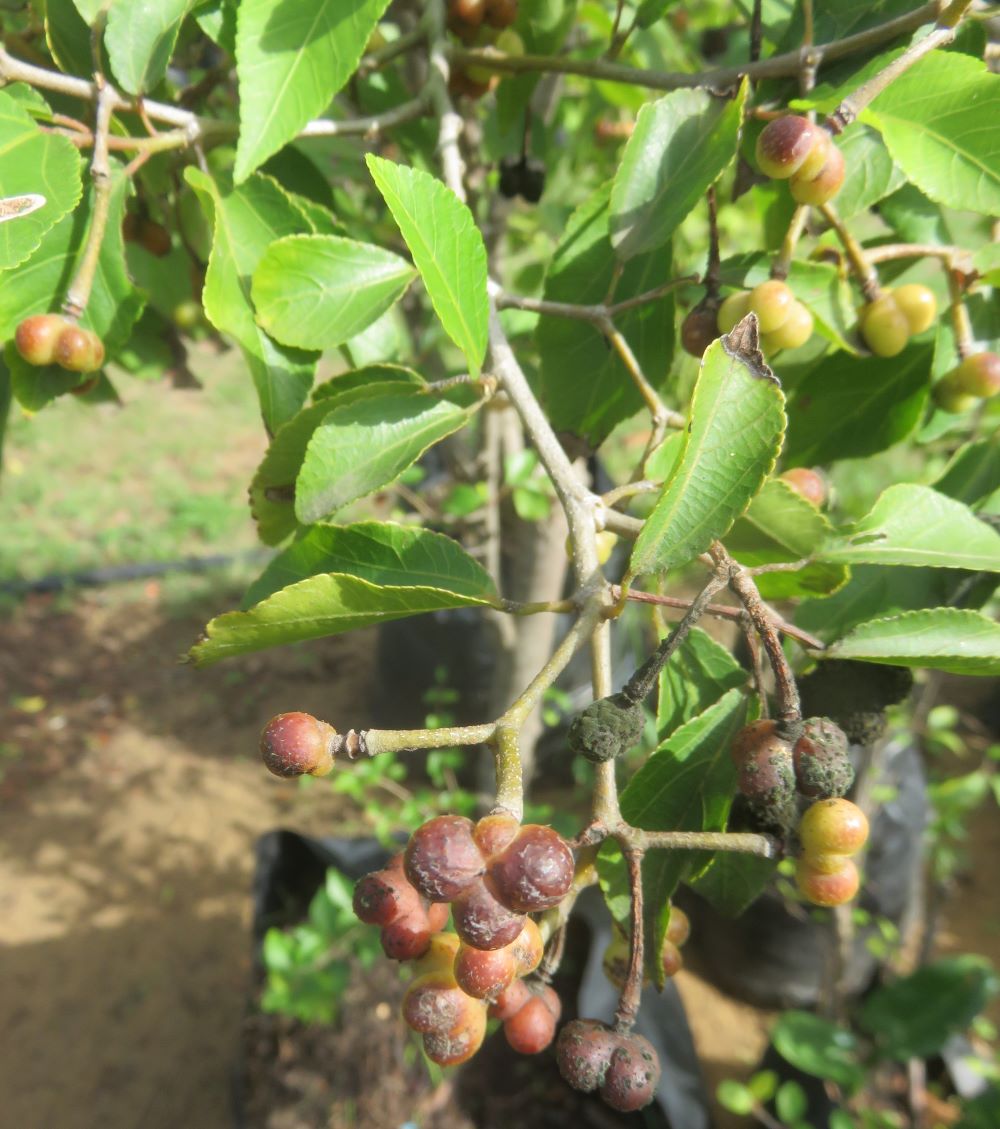 Grewia has small neat leaves.
Grewia has small neat leaves.Glossy green leaves
The tree is usually evergreen, and loses its leaves only for a short period in regions with very cold and dry winters. The leaves are glossy, or semi glossy, deep green, or olive green, and sometimes hairy, 2 to 7 cm long and 2 to 4 cm broad. The leaf is simple, elliptic to ovate, or ovate lanceolate, and they alternate on the stem. The margin is finely serrated or scalloped, tapering to a pointed or rounded apex, whereas the leaf base is rounded. The leaf base is symmetrical with 3 veins branching from it and a 0.5 to 2 cm petiole. It has no thorns.
(references 1, 2, 3, 4, 5, 9)
Bark
While the younger branches of Grewia occidentalis are reddish brown and pubescent, the bark of older branches is smooth, mottled dark and pale grey, and the branches are rounded.
(references 2,9).
Natural distribution
The distribution of Grewia occidentalis illustrates its flexibility. Grewia occidentalis var. occidentalis has a wide natural range in southern Africa in diverse types of habitat. It is found from Cape Town in the Western Cape all the way up the eastern coast and interior of South Africa into Mozambique and Eastern Zimbabwe. Other varieties of G.occidentalis are found further north all the way to Senegal, Ethiopia and the Middle East. It is found in very different contexts, from arid karoo to coastal dune bush. savannah-bushveld, savannah-lowveld, thicket, grassland and evergreen Afromontane forest habitats. In forests it behaves like a semi climber, on the forest margins as a shrub or small tree, and as an under storey shrub in dry woodland, bushveld, thicket or on stony outcrops.
(references 1,2,3,5,8).
Propagation
Four authors claim that Grewia occidentalis is best grown from seed. The problem with this is its obvious some people have been copying and pasting from other articles as the wording is identical. When this happens the information is likely not from first hand experience and not only seeds, but myths are propagated. Another frequent trope is that the cross-berry seed must pass through the gut of a monkey, otherwise germination is unpredictable. I would have thought the monkey would be a more unpredictable factor. But studies have shown that seeds which have passed through the gut of either monkeys or baboons germinate better. Perhaps if you don't have a baboon available, you could try being a surrogate, after all, they are relatives of ours. The germination improves because, like many of our tree seeds, they have a germination inhibiting chemical in their coat, and this is broken down by stomach acids. But have hope. Other authors claim germination is good, even without a monkey, and if you don't fancy using yourself as the 'monkey' you could always etch the seed with hydrochloric acid. You can also leach the seeds in water for two days and plant them in well drained loam. If you keep them at a constant humidity and a temperature between 24-28 degrees centigrade they should germinate within 2-6 weeks, according to the authors from Monaco. Cuttings, offshoots and layering are other propagation strategies.
I think the words of Glenice Ebedes have a lot of credibility and sound like she's actually done this. She states in exchanges with readers that the seeds of Grewia occidentalis can be planted with the flesh still on them, and are most viable when very fresh. This means sowing the seeds during the fruiting season in summer to late summer (January to May in South Africa). She claims that the germination rate is 70-80% in ideal conditions and the growth rate of the seedlings will also depend on your context. They should be sown in a bed of 5:1 river sand to compost, and transplanted at about 5-10 cm in to individual pots in a normal potting medium.
We have a veritable rainbow of conflicting information, on how to grow these wonderful trees. This is quite common with research on native African plant propagation ! What you can do is experiment, over sow, try and cover all the bases, and please let us know how it went !
(references 3, 4, 8, 9).
If you do not feel up to propagating this plant yourself, or cannot afford the time to wait for them to grow large, you can buy tough organic Grewia occidentalis from a local nursery: Toos van den Berg's nursery in Kraaifontain, Cape Town. The nursery specializes in unusual plants and native species and has a large stock of this special plant.
Names
As can be expected from such a useful plant with such a wide dispersal, a host of common names have been recorded for Grewia occidentalis. These which follow do not even include those of north east Africa and the middle East !
In southern Africa Grewia occidentalis is known as motshwarabadikana (Northern SeSotho), molutu (South SeSotho), liklolo (SiSwati) nsihana (Xitsonga), mokukuto (Setswana), mulembu (Tshivenda), umnqabaza (isiXhosa) and ilananyathi (isiZulu). Some other African names are mentioned without specifying the language in which they are found such as iLalangathi, iManhlele, mogwana, mokukutu, mumaka, UmSipane. I guess the language belong in the Bantu language family by their sound, so they do not include Ethiopia and areas up north. My apologies that some of the sources are incomplete in this way. If you know where these names belong please let me know. The incredible linguistic diversity the names embody is a testament to how loved and well used this indigenous food and medicine plant is throughout the areas of its natural distribution.
In the languages of the settlers such as South African English, it is known as the cross-berry, pink donkeyberry, assegaai wood, bow wood, button wood, lavendar star flower, star flower, and in Afrikaans as kruisbessie, assegaaibos, booghout or kruisbessieboom. Thus some of the English names are literal translations of Afrikaans, except rosyntjiebos which would be 'raisinbush' and pylhout which would be 'arrow-wood'. The deep history of the use of Grewia occidentalis in Africa and the middle east and the beauty of our indigenous botanical culture is my eighteenth reason for planting it.
The Latin genus name Grewia is after an English physician and plant anatomist of the 17th Century, Nehemiah Grew (what a great name for a plantsman !). The species name occidentalis means 'of the west' which is misleading as the plant is found along the east coast of South Africa. As is typical of a plant which was first described scientifically in the 18th Century, it has been given a range of Latin names over the centuries. Synonyms for Grewia occidentalis are G.ulmifolia, G. obtusifolia, G. trinervis, G. chirindae and G.microphylla.
(references 1, 2, 9).
Broader categorization
Grewia occidentalis is a member of the plant family Malvaceae. It was given a botanical description by Linnaeus in 1753. Its SAF number is 463 and its Zim number 598. Its close relative G. robusta looks similar, and G. flava, or the velvet raisin is found in the hot arid interior of South Africa.
(references 1, 2, 8, 11).
References
1.
Charles and Julia Botha Bring Nature back to your Garden
(page 113-114) has a very short description, and the book covers a
wealth of native plants.
2. https://witkoppenwildflower.co.za/grewia-occidentalis/© Malcolm Dee Hepplewhite & Witkoppen Wildflower Nursery, (Txt & Photos) 2012 & 2018 This page contains a very full description and covers lots of topics but not propagation.
3. https://en.wikipedia.org/wiki/Grewia_occidentalis The Wikipedia description is brief and derivative.
4. https://www.plantbook.co.za/grewia-occidentalis/ This useful page contains short descriptions of 20 aspects of the plant, detailed photos of leaves, flowers, fruit and bark, but the most useful was the comments section, where the horticulturist Glenice Ebedes commented on propagation and other topics.
5. https://af.wikipedia.org/wiki/Kruisbessie very short account in Afrikaans.
6. https://www.hallmarkchannel.com/home-and-family/how-to/pet-safe-plants contained just one comment on it being edible.
7. https://www.trees-sa.co.za/tree/grewia-occidentalis/ Lists possible uses in the garden and its performance as a garden plant.
8. http://pza.sanbi.org/grewia-occidentalis . This go-to website for all native South African plants contained about a page of information covering a wide range of topics briefly and gives 6 references for further reading.
9. https://www.monaconatureencyclopedia.com/grewia-occidentalis/?lang=en. A very thorough plant description for European and northern hemisphere growers. Written by Pietro Puccio, translated by Mario Beltramini.
10.https://www.merriam-webster.com/dictionary/cross-fertilization
11. https://www.gbif.org/species/4261391/treatments (about species names)
------
------
Restore Nature Newsletter
I've been writing for four years now and I would love to hear from you
Please let me know if you have any questions, comments or stories to share on gardening, permaculture, regenerative agriculture, food forests, natural gardening, do nothing gardening, observations about pests and diseases, foraging, dealing with and using weeds constructively, composting and going offgrid.
SEARCH
Order the Kindle E-book for the SPECIAL PRICE of only
Prices valid till 30.09.2023
Recent Articles
-
garden for life is a blog about saving the earth one garden at a time
Apr 18, 25 01:18 PM
The garden for life blog has short articles on gardening for biodiversity with native plants and regenerating soil for climate amelioration and nutritious food -
Cape Flats Sand Fynbos, Cape Town's most endangered native vegetation!
Apr 18, 25 10:36 AM
Cape Flats Sand Fynbos, a vegetation type found in the super diverse Cape Fynbos region is threatened by Cape Town's urban development and invasive alien plants -
Geography Research Task
Jan 31, 25 11:37 PM
To whom it may concern My name is Tanyaradzwa Madziwa and I am a matric student at Springfield Convent School. As part of our geography syllabus for this
"How to start a profitable worm business on a shoestring budget
Order a printed copy from "Amazon" at the SPECIAL PRICE of only
or a digital version from the "Kindle" store at the SPECIAL PRICE of only
Prices valid till 30.09.2023







